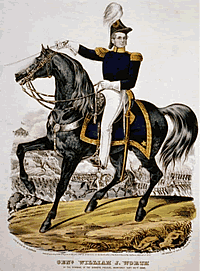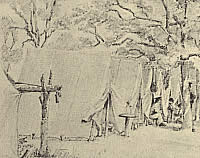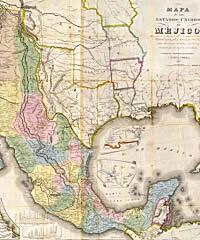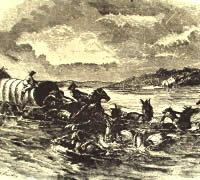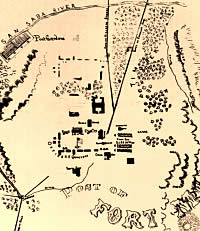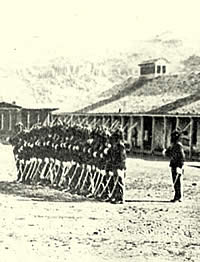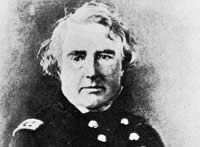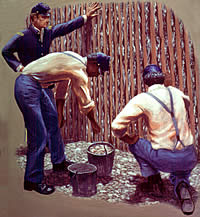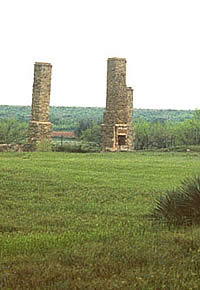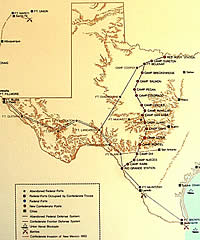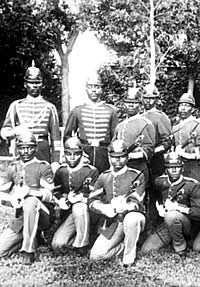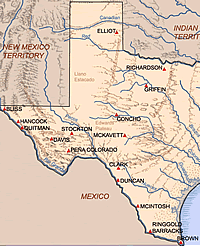
A total of 219 engagements between
the army and the Indians in Texas can be documented;
of these, 158 can be classified into the categories
shown. Click for detail.
|
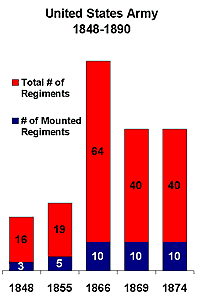
Composition of U.S. Army. Over time,
a chronic shortage of mounted troops heightened the
army's difficulties in meeting an increasing variety
of assignments. Click to enlarge.
|
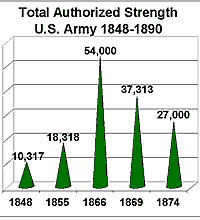
Total strength of the U.S. army from
1848 to 1874. Texans never felt they had their fair
share of troop resources, although in 1856, fully 25%
of the entire army was based in Texas.
|
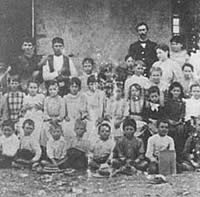
School class at Fort McKavett, Texas,
1894. (Click to see full image.) Schools, roads, churches
and jobs were among the many benefits brought by the
U.S. army to Texas. Photo courtesy Fort McKavett SHS,
Texas Parks and Wildlife Department.
|
|
Frontier forts served as bases from which scouts,
pursuits, large-scale offensives, and escorts or guards were
launched. Before the Civil War, most common was combat resulting
from a successful pursuit, triggered by information gleaned
by post or detachment commanders that Indians had been discovered.
Following the war, however, most engagements stemmed from
routine scouts, sent to interdict likely avenues of approach
or widely used trails or waterholes.
Most of the successful large-scale expeditions,
involving several companies engaged in campaigns that were
projected to take longer and involve greater distances, also
came after 1865. Combat involving mail parties, stagecoaches,
and construction teams accounted for less than 10 percent
of all engagements. The overwhelming majority of the fights
were short and badly fragmented skirmishes involving about
three dozen combatants per side. Sixty-four soldiers were
killed and 116 wounded during these clashes; the army reported
424 Indians killed, 112 wounded, and 267 taken prisoner.
Assessing the true military effectiveness of
the frontier forts in Texas is difficult. As historian Robert
Utley has noted, many officers saw the wars against the Indians
as a "fleeting bother," not worthy of the time or
energy it would take to develop tactics or strategy suitable
to such conflicts. Successful officers developed methods through
personal observation, by trial and error, by word of mouth,
or by individual ingenuity rather than through recognized
army doctrine.
The vast majority of scouts, pursuits, and large-scale
campaigns found no Indians. Pointing to the futility of such
efforts, Texans often charged that the federal government
never devoted sufficient resources to their state. Although
such claims often made for good politics with the folks back
home, in reality Texas probably exceeded its fair share of
War Department resources; in 1856, for example, fully twenty-five
percent of the entire army was based in Texas. More telling,
if less politically popular, was the argument that the army
was simply too small to carry out all the responsibilities
expected of it. In addition to fighting Indians, regulars
garrisoned coastal defensive fortifications, provided assistance
to civilians in times of crisis, helped to maintain domestic
order, patrolled national parks, conducted scientific research,
and engaged in civil engineering jobs. The chronic shortage
of mounted troops exacerbated the army's difficulties.
Despite these shortfalls, the frontier forts
had an enormous impact on Texas history. As one observer exclaimed,
army forts served "as the oasis in the desert" for
many a weary traveler. The forts also provided a tremendous
economic stimulus. From 1849 to 1900, the army disbursed some
$70 million in Texas, an amount equivalent to more than twice
the valuation of all the assessed property in the state at
the time of its annexation. And with the army often came schools,
churches, roads, and surveys.
Offering jobs, profits, a modicum of American
culture, the army's forts often served as the genesis for
permanent civilian settlement, resulting in new towns like
San Angelo, Gatesville, Fort Davis, Fort Stockton, and Fort
Worth. Their presence also boosted the chances of existing
sites like San Antonio (usually the site of department headquarters),
Eagle Pass, Brownsville, and El Paso. As a legendary Texas
historian once put it, "No story of the Texas heritage
can be complete without telling the role its forts played
in making that heritage possible."
|

Cavalry Charge on the Plains. In
Texas, most of the successful large-scale expeditions
came after 1865. Painting by Frederick Remington, courtesy
Amon Carter Museum. Click to enlarge.
|
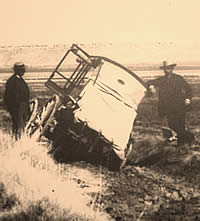
A stagecoach mired in the mud, on
mail route east of Fort Stockton, March 12, 1885. Escort
duty was a critical assignment for frontier troops.
Photo courtesy Fort Concho NHL. Click to enlarge.
|

An army encampment near Santa Rosa
Springs, circa 1884. Courtesy Fort Concho NHL. Click
to see full image.
|
|
No story of the Texas heritage can be complete without
telling the role its forts played in making that heritage
possible.
|
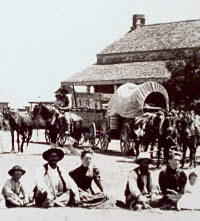
Families disembark their wagons for
a welcome rest at Fort Concho. As one observer has noted,
army forts served "as the oasis in the desert"
for many a weary traveler. Courtesy Fort Concho NHL.
|
|






